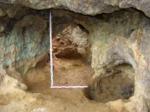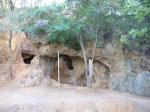Summary (English)
ARCHAEOLOGICAL EXPLORATIONS ON ADA TEPE HILL (Albrecht Jockenhövel – jockenh@uni-muenster.de, Hristo Popov) Seven sondages were carried out: sondage No. 1 situated on the upper western slopes of Ada Tepe Hill, sondages Nos. 3 – 4 situated on the upper eastern slopes, sondages Nos. 5 – 6 situated on the upper southwestern slopes, and sondages Nos. 2 and 7 situated on the lower northern slopes. A primary open mine was documented in sondage No. 1. After the mining was finished, the cut-out rocky slope was leveled and probably, a work platform functioned there for a short time, as evidenced from the fragmentary querns and pestles used for the ore processing. The pottery dated to the Late Bronze Age and was synchronous with the mining. A fragmentary mould for producing double axes of the Beguntsi type (14th – 13th centuries BC) was found in the periphery of the mine dumping in sondage No. 1. Evidently, the local Thracians who exploited the gold mine also practiced the bronze metallurgy and produced bronze tools and objects. Two periods (Late Bronze Age and Early Iron Age) were documented in sondages Nos. 3, 4 and 5. The occupation layers were up to 6.30 m thick. Multiple interruptions in the mining were documented. During the explorations in 2008 and 2009, mining in the upper slopes of Ada Tepe Hill was documented. The open mining was predominantly applied in the gold mines, but there was evidence for underground galleries, too. The traces from mining were discovered over an area of 0.42 – 0.45 sq. km. The mines were exploited mainly during the Late Bronze Age (15th – 11th centuries BC). During the Early Iron Age the mining gradually decreased and in the 8th – 7th centuries BC it stopped.
- Albrecht Jockenhövel - Abteilung für Ur- und Frühgeschichtliche Archäologie, Historisches Seminar, Westfälische Wilhelms-Universität
- Hristo Popov - Archaeological Institute with Museum
Director
Team
Research Body
- Archaeological Institute with Museum
- Westfälische Wilhelms-Universität






![Download [PDF]](/excavation/skins/fasti/images/results/download_sml.png)
